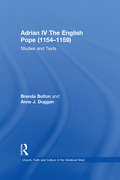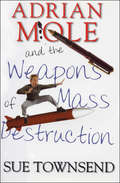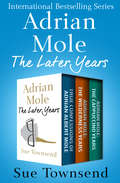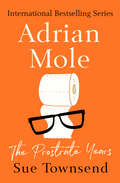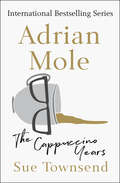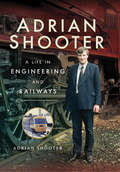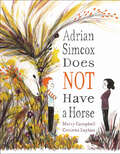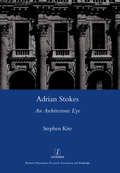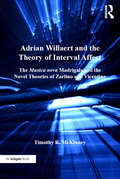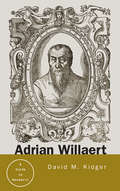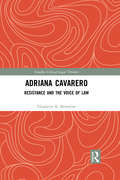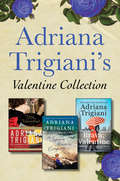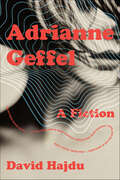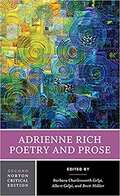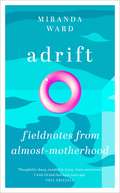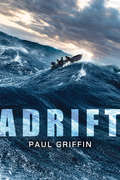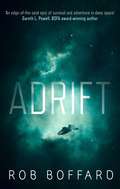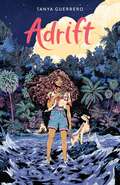- Table View
- List View
Adrian IV The English Pope: Studies and Texts (Church, Faith and Culture in the Medieval West)
by Anne J. Duggan Brenda BoltonThe year 2000 witnessed the 900th anniversary of the birth of Adrian IV, the only Englishman to sit on the papal throne. His short pontificate of four and a half years, distracted by crisis and controversy and followed as it was by an 18-year schism, could be judged a low point in the history of the papacy. The studies in this book challenge the view that Adrian was little more than a cipher, the tool of powerful factions in the Curia. This is the first large-scale work on Adrian since 1925, and is supported by a substantial appendix of relevant sources and documents in facing translation. Relations with the Empire, the Norman kingdom and the Patrimony are all radically reassessed and the authenticity of 'Laudabiliter' reconsidered. At the same time, the spiritual, educational and devotional contexts in which he was operating are fully assessed; his activities in Catalonia and his legatine mission to Scandinavia are examined in the light of recent research, and his special relationship with St Albans is explored through his privileges to this great abbey. These studies by leading scholars in the field, together with the introductory chapter by Christopher Brooke, reveal an active and engaged pope, reacting creatively to the challenges and crises of the Church and the world.
Adrian Ivinson at the Harvard Center for Neurodegeneration and Repair
by Robert Steven Kaplan Ayesha KanjiAdrian Ivinson is the director of Harvard Center for Neurodegeneration and Repair (HCNR), a not-for-profit research center at the Harvard Medical School (HMS). The center was started in late 2000 with a gift of $37.5 million from an anonymous donor. Its mandate was to conduct research that could lead to actual treatments for neurodegenerative disease (i.e., ALS, Parkinson's, Alzheimer's, MS, and Huntington's) and do so by encouraging collaboration among researchers in the HMS community. When Ivinson takes the helm in 2001, he finds a dysfunctional center with little organization or structure. In addition, he has little formal authority to make changes and he must navigate the complex culture of the HMS neurological research community as well as the HMS academic culture. Demonstrates Ivinson's efforts to develop HCNR as a catalyst for aligning scientific researchers in the HMS community by creating incentives for innovation and collaboration. Also, profiles the issues he faces as general manager at various stages of the organization's development--and how his style, priorities, and approach must change as the needs of the organization change. Provides an opportunity for action planning to address the major issues facing the HCNR at the end of 2005. Focuses on organizational culture, alignment, leadership style/fit, and change management.
Adrian Mole and the Weapons of Mass Destruction (Adrian Mole Ser. #7)
by Sue TownsendAdrian Mole's pen is scribbling for the twenty-first century. Working as a bookseller and living in Leicester's Rat Wharf; finding time to write letters of advice to Tim Henman and Tony Blair; locked in mortal combat with a vicious swan called Gielgud; measuring his expanding bald spot; and trying to escape the clutches of Marigold and win over her voluptuous sister Daisyhellip; Adrian still yearns for a better, more meaningful world. and he's not ready to surrender his pen yet.
Adrian Mole, The Early Years: The Secret Diary of Adrian Mole, Aged 13 ¾ and The Growing Pains of Adrian Mole (The Adrian Mole Series)
by Sue TownsendBritish adolescent angst has never been so &“laugh-out-loud funny&” (The New York Times)—the journey begins with these first two books in the heartbreakingly hilarious series. Commiserate with &“one of literature&’s most endearing figures&” (The Observer)—a sharp-witted, pining, and achingly honest underdog of great expectations and dwindling patience who knows all (or believes he does) and tells all. First published in 1982, Adrian Mole&’s chronicle of angst has sold more than 20 million copies worldwide, spawned seven sequels, been adapted for television, and staged as a musical—truly &“a phenomenon&” (The Washington Post). The Secret Diary of Adrian Mole, Aged 13and ¾: Adrian Mole must amass his grievances—his acne vulgaris is grotesque; his crush, Pandora, has received seventeen Valentine&’s Day cards (seventeen!); his PE teacher is a sadist; he fears his parents&’ marriage is over since they no longer smoke together; his dog has gone AWOL; no one appreciates his poetry; and Animal Farm has set him off pork for good. If everyone were as appalled as Adrian Mole, it would be a better world. For now, for us, it&’s just &“screamingly funny&” (The Sunday Times). The Growing Pains of Adrian Mole: Growing up among inferiors in Great Britain isn&’t easy for a sensitive &“poet of the Midlands&” like Adrian, considering everything in the world is conspiring to scar him for life—his hormones are in a maelstrom; his mother is pregnant (at her age!); his girlfriend is in shut down; and he&’s become allergic to non-precious metals. As his &“crisply hilarious saga&” (Booklist) continues, the changes Adrian undergoes will surely be profound. &“Townsend&’s wit is razor sharp&” (Daily Mirror) as she shows us the world through the haunted eyes of her luckless teenage diarist and self-proclaimed &“undiscovered intellectual,&” proving again and again why she&’s been called &“a national treasure&” (The New York Times Book Review).
Adrian Mole, The Later Years: True Confessions of Adrian Albert Mole, Adrian Mole: The Wilderness Years, and Adrian Mole: The Cappuccino Years (The Adrian Mole Series)
by Sue TownsendAs his laugh-out-loud secret diary extends into his later teens and young adulthood, everyone&’s favorite angsty Brit remains &“a brilliant comic creation&” (The Times, London). Continue to commiserate with &“one of literature&’s most endearing figures&”—a sharp-witted, pining, and achingly honest underdog of great expectations and dwindling patience who knows all (or believes he does) and tells all (The Observer). Having endured the agony of adolescence (just), Adrian now careens into his later teens, torturous twenties, and utterly disappointing thirties in these three hilarious sequels by &“one of Britain&’s most celebrated comic writers&” (The Guardian). From the not-so-humble origins of The Secret Diary of Adrian Mole Aged 13 and ¾, Adrian&’s chronicle of angst has sold more than twenty million copies worldwide, spawned seven sequels, been adapted for television, and staged as a musical—truly &“a phenomenon&” (The Washington Post). The True Confessions of Adrian Albert Mole: What&’s happening to Adrian Mole? On the one hand, he&’s entering the cusp of adulthood and burgeoning success as a published poet. On the other, he still lives at home, refuses to part with his threadbare stuffed rabbit, and has lost his job at the library for a shocking act of impudence: He shelved Jane Austen under Light Romance. Even worse, someone named Sue Townsend stole his diaries and published them under her own name. Of course they were bestsellers. Adrian Mole: The Wilderness Years: At 23¾ years old, Adrian is now technically an adult and almost prepared. On the upside: He&’s fallen for a perfectly lovely Nigerian waitress; he&’s seeing a therapist so as to talk about himself without interruption; and he&’s added vowels to his experimental novel-in-progress (so much more accessible to the masses!). The downside? Pandora is probably history; a pea-brained rival has been published before him to great acclaim; and worse—Adrian has come to the devastating realization that he may not be uncommon after all. Adrian Mole: The Cappuccino Years: At 34¾, impotent intellectual Adrian Mole is soon to be divorced; he hasn&’t a clue what to do with his semi-stardom as a celebrity chef; his parents have become swingers (with whom is too shocking to go into now); his epic novel is still unpublished; his ex-flame Pandora is running for political office; and his younger sister has rebelled in the most distressingly common ways. There is one upside: Adrian&’s son has inherited his mother&’s unblemished skin. &“Townsend&’s wit is razor sharp&” (Daily Mirror) as she shows us the world through the older and (possibly?) wiser eyes of her &“achingly funny anti-hero&” (Daily Mail), proving again and again why she&’s been called &“a national treasure&” (The New York Times Book Review).
Adrian Mole: The Prostrate Years (The Adrian Mole Series #8)
by Sue TownsendThe final chapter in the beloved chronicles of an angsty Brit begun in The Secret Diary of Adrian Mole Aged 13¾ is &“a tour de force by a comic genius&” (Daily Mail). Am I turning into one of those middle-aged men who think the country has gone to the dogs and that there has been no decent music since Abba? Hard to believe! Adrian Mole is pushing forty, a beleaguered bookseller looking back through the wistful eyes of an unrecognized intellectual and, admittedly, pretty much of an Everyman. But he&’s also looking forward, despite a few things: His five-year-old daughter is showing alarming Stalinist traits; his son is fighting the Taliban and he&’s worried sick; his unfaithful wife is keeping a diary of her own and it&’s all rather heartbreaking; frequent urination has made him fear trouble &“down there;&” and his mother is penning a misery memoir that is one gross slog of a lie (born an aristocrat in a Norfolk potato field, indeed!). Then one day he receives a phone call out of the blue from the great and only love his life: Pandora Braithwaite. &“Do you think of me?&” she asks. Only ever since he was 13¾ . . . Adrian Mole&’s epic and hilarious chronicle of angst over a quarter century has sold more than twenty million copies worldwide, and been adapted for television and staged as a musical—truly &“a phenomenon&” (The Washington Post). This final volume is &“like rediscovering an old school friend on Facebook&” (Time Out), and &“if [it] isn&’t the best book published this year, I&’ll eat my bookshelf&” (Daily Mail).
Adrian Mole: The Wilderness Years (The Adrian Mole Series #4)
by Sue TownsendCan an adult still have a secret diary? Everyone’s favorite angsty adolescent Brit is now a tormented twentysomething and still “a brilliant comic creation” (The Times). Question: What have I done with my life? Answer: Nothing. At 23¾ years old, Adrian Mole is now an adult and almost prepared. On the upside: He’s fallen for a perfectly lovely Nigerian waitress; he’s seeing a therapist so as to talk about himself without interruption; and he’s added vowels to his experimental novel-in-progress (so much more accessible to the masses!). The downside? Pandora is probably history; a pea-brained rival has been published before him to great acclaim; and worse, Adrian realizes he may not be uncommon after all. In fact, he may fall somewhere within the range of normalcy. How can an intellectual be expected to live with that? “Thank God for Sue Townsend and Adrian Mole” (The Observer). Her “achingly funny anti-hero” (Daily Mail) returns to take the world by storm—or least weather it—in the beloved bestselling series from “one of Britain’s most celebrated comic writers” (The Guardian). Adrian’s continuing chronicle of angst has sold more than twenty million copies worldwide, and been adapted for television and staged as a musical—truly “a phenomenon” (The Washington Post).
Adrian Mole: True Confessions Of Adrian Albert Mole, Adrian Mole: The Wilderness Years, And Adrian Mole: The Cappuccino Years (The Adrian Mole Series #5)
by Sue TownsendThe &“wickedly satirical, mad, ferociously farcical [and] subversive&” angsty Brit of secret diary fame careens into his thirties (Daily Mail). I expect that by tomorrow I will have embellished the story and given myself a heroic status I do not deserve . . . Right now the truth is harrowing enough for aging, impotent intellectual Adrian Mole: He&’s soon to be divorced; he hasn&’t a clue what to do with his semi-stardom as a celebrity chef; his parents have become swingers (with whom is too shocking to go into now); his epic novel is still unpublished; his ex-flame Pandora is running for political office; and his younger sister has rebelled in the most distressingly common ways. But there&’s one upside: Adrian&’s son has inherited his mother&’s unblemished skin. Is it any wonder that at 34¾ Adrian is still punishingly self-aware and willfully deluded about what he&’s endured and what he&’s yet to achieve? Struggling somewhere between breakthrough and breakdown, he&’s telling his diary everything. The result? Adrian&’s fifth Book of Revelation—and it&’s &“quite possibly, a classic&” (Daily Mirror).
Adrian Rollini: The Life and Music of a Jazz Rambler (American Made Music Series)
by Ate van Delden2020 Association for Recorded Sound Collections Awards for Excellence—Best History in the category of Best Historical Research in Recorded JazzAdrian Rollini (1903–1956), an American jazz multi-instrumentalist, played the bass saxophone, piano, vibraphone, and an array of other instruments. He even introduced some, such as the harmonica-like cuesnophone, called Goofus, never before wielded in jazz. Adrian Rollini: The Life and Music of a Jazz Rambler draws on oral history, countless vintage articles, and family archives to trace Rollini’s life, from his family’s arrival in the US to his development and career as a musician and to his retirement and death. A child prodigy, Rollini was playing the piano in public at the age of five. At sixteen in New York he was recording pianola rolls when his peers recognized his talent and asked him to play xylophone and piano in a new band, the California Ramblers. When he decided to play a relatively new instrument, the bass saxophone, the Ramblers made their mark on jazz forever. Rollini became the man who gave this instrument its place. Yet he did not limit himself to playing bass parts—he became the California Ramblers’ major soloist and created the studio and public sound of the band. In 1927 Rollini led a new band that included such jazz greats as Bix Beiderbecke and Frank Trumbauer. During the Depression years, he was back in New York playing with several bands including his own New California Ramblers. In the 1940s, Rollini purchased a property on Key Largo. He rarely performed again for the public but hosted rollicking jam sessions at his fishing lodge with some of the best nationally known and local players. After a car wreck and an unfortunate hospitalization, Rollini passed away at age fifty-three.
Adrian Shooter: A Life in Engineering and Railways
by Adrian ShooterThis book is the tale of a small boy from Surrey who had a fascination with anything on wheels and, also, loved to learn about people and what motivated them. He read a lot about railways and was excited by the innovations of our nineteenth-century predecessors. When the Beeching report came out in 1963, he decided that he wanted to be a part of the new order and help bring back some of that excitement. He describes his upbringing and paints a picture of the 'greyness' of the 1950s and then takes the reader on a voyage of discovery into the world of 1960's engineering before he joined British Railway in 1970.The view from the inside presents readers with a whole new picture of what was really going on within British Rail at various levels. Much that is reported has never before been published and the reasons for many decisions on previously opaque matters are explained.The author was cautioned by his school careers master to be wary of saying what he really thought. It seems that this piece of advice has not been heeded.
Adrian Simcox Does NOT Have a Horse
by Marcy CampbellA classic in the making, this heartwarming story about empathy and imagination is one that families will treasure for years to come.Adrian Simcox tells anyone who will listen that he has a horse--the best and most beautiful horse anywhere.But Chloe does NOT believe him. Adrian Simcox lives in a tiny house. Where would he keep a horse? He has holes in his shoes. How would he pay for a horse?The more Adrian talks about his horse, the angrier Chloe gets. But when she calls him out at school and even complains about him to her mom, Chloe doesn't get the vindication she craves. She gets something far more important.Written with tenderness and poignancy and gorgeously illustrated, this book will show readers that kindness is always rewarding, understanding is sweeter than judgment, and friendship is the best gift one can give.
Adrian Stokes: An Architectonic Eye
by Stephen Kite"Adrian Stokes (1902-72) - aesthete, critic, painter and poet - is among the most original and creative writers on art of the twentieth century. He was the author of over twenty critical books and numerous papers: for example, the remarkable series of books published in the 1930s; The Quattro Cento (1932), Stones of Rimini (1934), and Colour and Form (1937) that embraced Mediterranean culture and modernity. His criticism extends the evocative English aesthetic tradition of Walter Pater and John Ruskin into the present, endowed by a stern sensibility to the consolations offered by art and architecture, and the insights that psychoanalysis affords. Indeed, for Stokes architecture provides the entree into art, and this book is the first study to comprehensively examine Stokess theory of art from a specifically architectonic perspective. The volume explores the crucial experiences through which this architectonic awareness evolved; traces the influence upon Stokes of places, texts and personalities, and examines how his theory of art developed and matured. The argument is supported by appropriate illustrations to confirm the evidence that Stokess claim for architecture as mother of the arts carries the deepest experiential and psychological import."
Adrian Willaert and the Theory of Interval Affect: The Musica nova Madrigals and the Novel Theories of Zarlino and Vicentino
by Timothy R. McKinneyIn the writings of Nicola Vicentino (1555) and Gioseffo Zarlino (1558) is found, for the first time, a systematic means of explaining music's expressive power based upon the specific melodic and harmonic intervals from which it is constructed. This "theory of interval affect" originates not with these theorists, however, but with their teacher, influential Venetian composer Adrian Willaert (1490-1562). Because Willaert left no theoretical writings of his own, Timothy McKinney uses Willaert's music to reconstruct his innovative theories concerning how music might communicate extramusical ideas. For Willaert, the appellations "major" and "minor" no longer signified merely the larger and smaller of a pair of like-numbered intervals; rather, they became categories of sonic character, the members of which are related by a shared sounding property of "majorness" or "minorness" that could be manipulated for expressive purposes. This book engages with the madrigals of Willaert's landmark Musica nova collection and demonstrates that they articulate a theory of musical affect more complex and forward-looking than recognized currently. The book also traces the origins of one of the most widespread musical associations in Western culture: the notion that major intervals, chords and scales are suitable for the expression of happy affections, and minor for sad ones. McKinney concludes by discussing the influence of Willaert's theory on the madrigals of composers such as Vicentino, Zarlino, Cipriano de Rore, Girolamo Parabosco, Perissone Cambio, Francesco dalla Viola, and Baldassare Donato, and describes the eventual transformation of the theory of interval affect from the Renaissance view based upon individual intervals measured from the bass, to the Baroque view based upon invertible triadic entities.
Adrian Willaert: A Guide to Research (Routledge Music Bibliographies)
by David KidgerThis key text will be the first full-length research tool on Adrian Willaert, the Renaissance composer of motets and madrigals who came to prominence in the first part of the sixteenth century, and should prove invaluable to researchers and students.
Adrian's Librarian
by Hollis ShilohOne night at a masquerade party, rakish Adrian Knowles kisses the wrong man by mistake and meets Oliver Windham. Feisty yet wary and broken, Ollie desperately needs a friend. Almost against his will, Adrian finds himself playing the hero... and falling in love. Adrian hires Ollie to set his library to rights--after having his servants put all the books out of order. He promises himself he'll treat Ollie only as a friend, but Ollie quickly becomes the only man he wants. A Timeless Dreams title: While reaction to same-sex relationships throughout time and across cultures has not always been positive, these stories celebrate M/M love in a manner that may address, minimize, or ignore historical stigma.
Adriana Cavarero: Resistance and the Voice of Law (Nomikoi: Critical Legal Thinkers)
by Elisabetta R. BertolinoCritical legal scholars have made us aware that law is made up not only of rules but also of language. But who speaks the language of law? And can one lawfully speak in one’s voice? For the Italian philosopher Adriana Cavarero, to answer these questions we must not separate who is speaking from the very act of speaking; moreover, we must recuperate the material singularity and relationality of the mouth that speaks. Drawing on Cavarero’s work, this book focuses on the potentiality of the voice for resisting law’s sovereign structures. For Cavarero, it is the voice that expresses one’s living and unrepeatable singularity in a way that cannot be subsumed by the universalities and standards of law. The voice is essentially a material and singular passage of air and vibration that necessarily reveals one’s uniqueness in relationality. Speaking discloses this uniqueness, and so one’s vulnerability. It therefore leads to possibilities of resistance that, here, bring a fresh approach to longstanding legal theoretical concerns with singularity, ethics and justice.
Adriana Trigiani's Valentine Collection
by Adriana TrigianiFrom New York Times bestselling author Adriana Trigiani comes her beloved Valentine trilogy, now available in one volume for the first time. This eBook collection includes Very Valentine, Brava, Valentine, and The Supreme Macaroni Company.
Adrianne Geffel: A Fiction
by David HajduThis never-before-told story of the life and work of a (fictitious) musical phenomenon is "a revealing—and at times hilarious—satire of the music business, fame, and the cult of personality" (Clea Simon, Boston Globe).Adrianne Geffel was a genius. Praised as the “Geyser of Grand Street” and the “Queen of Bleak Chic,” she was a one-of-a-kind artist, a pianist and composer with a rare neurological condition that enabled her to make music that was nothing less than pure, unmediated emotional expression. She and her sensibility are now fully integrated into the cultural lexicon; her music has been portrayed, represented, and appropriated endlessly in popular culture. But what do we really know about her? Despite her renown, Adrianne Geffel vanished from public life, and her whereabouts remain a mystery to this day.David Hajdu cuts through the noise to tell, for the first time, the full story of Geffel’s life and work, piecing it together through the memories of those who knew her, inspired her, and exploited her—her parents, teachers, best friend, manager, critics, and lovers. Adrianne Geffel made music so strange, so compelling, so utterly unique that it is simply not to be believed. Hajdu has us believing every note of it in this slyly entertaining work of fiction.A brilliantly funny satire, with characters that leap off the page, Adrianne Geffel is a vividly twisted evocation of the New York City avant-garde of the 1970s and ’80s, and a strangely moving portrait of a world both utterly familiar and like none we’ve ever encountered.
Adriatic: A Concert of Civilizations at the End of the Modern Age
by Robert D. Kaplan&“[An] elegantly layered exploration of Europe&’s past and future . . . a multifaceted masterpiece.&”—The Wall Street Journal&“A lovely, personal journey around the Adriatic, in which Robert Kaplan revisits places and peoples he first encountered decades ago.&”—Peter Frankopan, author of The Silk RoadsIn this insightful travelogue, Robert D. Kaplan, geopolitical expert and bestselling author of Balkan Ghosts and The Revenge of Geography, turns his perceptive eye to a region that for centuries has been a meeting point of cultures, trade, and ideas. He undertakes a journey around the Adriatic Sea, through Italy, Slovenia, Croatia, Montenegro, Albania, and Greece, to reveal that far more is happening in the region than most news stories let on. Often overlooked, the Adriatic is in fact at the center of the most significant challenges of our time, including the rise of populist politics, the refugee crisis, and battles over the control of energy resources. And it is once again becoming a global trading hub that will determine Europe&’s relationship with the rest of the world as China and Russia compete for dominance in its ports. Kaplan explores how the region has changed over his three decades of observing it as a journalist. He finds that to understand both the historical and contemporary Adriatic is to gain a window on the future of Europe as a whole, and he unearths a stark truth: The era of populism is an epiphenomenon—a symptom of the age of nationalism coming to an end. Instead, the continent is returning to alignments of the early modern era as distinctions between East and West meet and break down within the Adriatic countries and ultimately throughout Europe. With a brilliant cross-pollination of history, literature, art, architecture, and current events, in Adriatic, Kaplan demonstrates that this unique region that exists at the intersection of civilizations holds revelatory truths for the future of global affairs.
Adrienne Kennedy Reader
by Adrienne KennedyIntroduction by Werner SollorsAdrienne Kennedy has been a force in American theatre since the early 1960s, influencing generations of playwrights with her hauntingly fragmentary lyrical dramas. Exploring the violence racism visits upon people&’s lives, Kennedy&’s plays express poetic alienation, transcending the particulars of character and plot through ritualistic repetition and radical structural experimentation. Frequently produced, read, and taught, they continue to hold a significant place among the most exciting dramas of the past fifty years. This first comprehensive collection of her most important works traces the development of Kennedy&’s unique theatrical oeuvre from her Obie-winning Funnyhouse of a Negro (1964) through significant later works such as A Movie Star Has to Star in Black and White (1976), Ohio State Murders (1992), and June and Jean in Concert, for which she won an Obie in 1996. The entire contents of Kennedy&’s groundbreaking collections In One Act and The Alexander Plays are included, as is her earliest work "Because of the King of France" and the play An Evening with Dead Essex (1972). More recent prose writings "Secret Paragraphs about My Brother," "A Letter to Flowers," and "Sisters Etta and Ella" are fascinating refractions of the themes and motifs of her dramatic works, even while they explore new material on teaching and writing. An introduction by Werner Sollors provides a valuable overview of Kennedy&’s career and the trajectory of her literary development. Adrienne Kennedy (b. 1931) is a three-time Obie-award winning playwright whose works have been widely performed and anthologized. Among her many honors are the American Academy of Arts and Letters award and the Guggenheim fellowship. In 1995-6, the Signature Theatre Company dedicated its entire season to presenting her work. She has been commissioned to write works for the Public Theater, Jerome Robbins, the Royal Court Theatre, the Mark Taper Forum, and Juilliard, and she has been a visiting professor at Yale, Princeton, Brown, the University of California at Berkeley, and Harvard. She lives in New York City.
Adrienne Rich: Poetry and Prose
by Adrienne Rich Albert Gelpi Barbara Charlesworth Gelpi Brett C. MillierThis Norton Critical Edition includes: <p><p> • Generous selections of poetry and prose from the entire oeuvre of one of America’s most influential poets. • An introduction and explanatory annotations by Barbara Charlesworth Gelpi, Albert Gelpi, and Brett Millier. • Fifteen reviews and critical commentaries, nine of them new to the Second Edition, carefully chosen as a guide to Adrienne Rich’s poetics―and to her poetics as related to politics―ranging from W. H. Auden’s 1951 response to her first book to critics’ reviews of the magisterial Collected Poems in 2016. • A Chronology, a Selected Bibliography, and an Index.
Adrift
by Miranda Ward‘The world is not neatly divided into two camps of women, those who wanted to reproduce and did, and those who didn’t want to, and didn’t. So many of us are caught here, in between, neither one thing nor the other, drifting towards a receding horizon, in our own camp . . .’
Adrift
by Paul GriffinFrom critically acclaimed writer Paul Griffin comes a fast-paced young adult novel about five very different teens lost at sea with no one to count on but each other.Matt and John are best friends working out in Montauk for the summer. When Driana, JoJo and Stef invite the boys to their Hamptons mansion, Matt and John find themselves in a sticky situation where temptation rivals sensibility. The newfound friends head out into the Atlantic after midnight in a stolen boat. None of them come back whole, and not all of them come back.Worlds collide when the group ventures out to sea aboard an antique ship that Stef sneaks out from her dad's dock. As the waves rise and the fragile vessel weakens, things go horribly wrong. Adrift at sea for days, who will have what it takes to survive?
Adrift
by Rob Boffard"An edge-of-the-seat epic of survival and adventure in deep space." - Gareth L. Powell, BSFA Award-Winning authorSigma Station. The ultimate luxury hotel, in the far reaches of space.For one small group, a tour of the Horsehead Nebula is meant to be a short but stunning highlight in the trip of a lifetime.But when a mysterious ship destroys Sigma Station and everyone on it, suddenly their tourist shuttle is stranded.They have no weapons. No food. No water. No one back home knows they're alive.And the mysterious ship is hunting them.For more from Rob Boffard, check out:The Outer Earth TrilogyTracerZero - GImpactOuter Earth (Omnibus Edition)
Adrift
by Tanya GuerreroFrom Tanya Guerrero, the author of All You Knead Is Love and How to Make Friends with the Sea, comes Adrift, an upper middle grade contemporary story of survival and grief about two biracial Filipino cousins whose resilience is tested when one of them is lost at sea.Cousins Coral and Isa are so close that they're practically siblings; their mothers are sisters, and the two girls grew up on the same small island. When Coral and her parents leave on a months-long sea voyage amid the islands of Indonesia, Isa is devastated that they'll be kept apart, and the two vow to write to each other no matter what.Then the unthinkable happens, and Coral's boat capsizes at sea, where her parents vanish. Washed up on a deserted island, alone and wracked by grief, she must find the strength within to survive, and find her way back home. Meanwhile, Isa is still on Pebble Island, the only one holding out hope that her beloved cousin is still alive.Told in alternating points of view, this is a powerful story of loss and hope, love and family—and the unexpected resilience of the human spirit.
